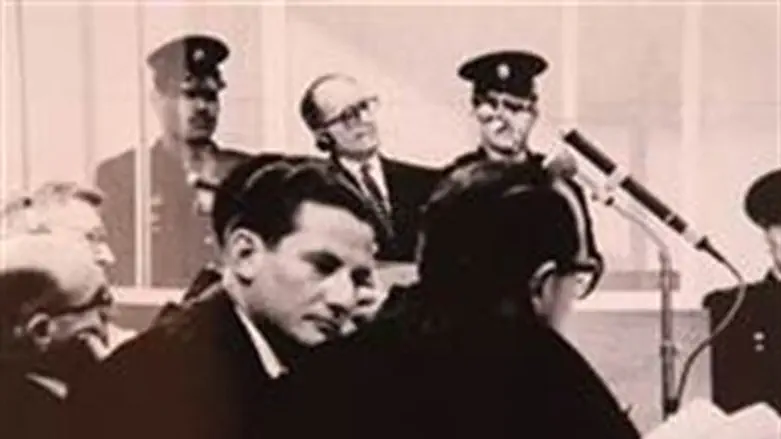
A new Knesset exhibition will commemorate the 50th anniversary of the verdict against Adolf Eichmann, who was instrumental in the planning and execution of Nazi Germany's “final solution,” the direct result of which was the murder of over 6 million Jews during the Holocaust. Among the items to be displayed will be the infamous “glass booth” that Eichmann sat in during his trial in Jerusalem in 1961. The booth was brought to the Knesset Thursday, in a complicated operation to ensure its safety.
Eichmann was assigned from the beginning to Nazi control of Germany, and later Europe, with finding an answer to the “Jewish question” - removing Jews from Europe, either by emigration or other means. Eichmann was the “Transportation Administrator” for the Final Solution, in charge of the trains that carried Jews to the death camps throughout Europe. He carried out his mission faithfully, continuing to move Jews to the gas chambers in the waning days of World War II.
After the war, Eichmann escaped from Germany using a series of fake identities and false passports. He was briefly held by American forces but managed to escape – eventually ending up in Argentina, where he lived in obscurity under the name “Ricardo Klement.” Israeli Mossad agents tracked down his whereabouts, and eventually arrested him and brought him to Israel.
Eichmann's trial began on April 11, 1961, and he was indicted on 15 criminal charges, including crimes against humanity, war crimes, crimes against the Jewish people, and membership in an outlawed organization. The trial struck a strong emotional chord among Israelis and Jews around the world, as many Holocaust survivors testified at the trial – telling personal histories of suffering and torture that many had not shared since being liberated from the death camps. On December 11, the three judges presiding at the trial - Moshe Landau, Benjamin Halevy, and Yitzhak Raveh – declared Eichmann guilty and sentenced him to death, the first and so far only time that a criminal has been sentenced to be executed in Israel. His sentence – death by hanging – was carried out on May 31, 1962. His body was cremated and his ashes spread over the Mediterranean Sea.
Several months ago, Yad Vashem posted the entire trial online. The story of Eichmann's arrest, capture and trial has inspired many books, at least one play, and several movies, the most well-known of which was 1975's “The Man in the Glass Booth,” based on the 1967 novel of the same name by Robert Shaw.
A special ceremony opening the exhibition will take place at the Knesset next Monday. Attending will be Prime Minister Binyamin Netanyahu, former Minister Rafi Eitan – a member of the Mossad team that arrested Eichmann – and former Mossad deputy chief Avraham Shalom. Isser Harel, who headed the Mossad at the time of Eichmann's capture, passed away in 2003.
The glass booth has been on display since the end of the trial at Kibbutz Lochamei Hageta'ot, founded by Holocaust survivors, in northern Israel, and has been displayed in different venues over the years. Four months ago, the booth was sent abroad for the first time – to Germany, for an exhibition on the Holocaust.
Along with the booth, other items relating to Eichmann will be on display, including the chair he sat on during the trial, the keys to the safe house where Eichmann was kept on Garibaldi Street in Buenos Aires until he was moved to Israel, the false passports used by the arresting Mossad agents, and several items that Eichmann had in his possession at the time of his arrest.